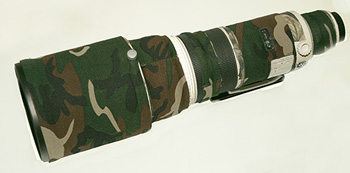

Anyone using a big white Canon lens will, eventually, scratch and chip and otherwise mar the white surface of the lens, at least if you shoot in the field and actually use your gear! Many of my lenses that I've owned over the years have looked like they were owned by a war correspondent because of their looks - most of my big telephotos were no longer covered in white. None of these lenses had been dropped or banged, but simply, through the normal course of events in putting lenses in bags, sometimes resting a lens upon a rock, or innumerable other reasons, the white finish was rubbed off.
Nikon lenses, and other companies lenses as well, also have finished that will eventually be worn if they are not protected. My Nikon lenses, back in the days when I shot Nikon, suffered equal beauty challenges. Canon's white lenses, however, also have the potential to be distracting and also simply too noticeable. A big white lens could potentially spook a timid subject when the lens is moved. Wildlife, especially birds, often spook when confronted with rapid light changes - as the flick of a white lens may produce. White lenses are also too noticeable, and if I'm afield I'd prefer to blend in, often not because I'm trying to hide from the animals but to not be noticed by passing humans. In Yellowstone, a big lens seen from the road can invite curious on-lookers who may decide to traipse out into a field to investigate what you're shooting. With an inconspicuous lens, and especially if I'm wearing camouflag clothing, too, I don't attract that attention. For that reason, all of our lenses are covered in some type of camouflag cover, be that a rubberized coating or simply camouflag tape.
White tape does the job of camouflaging a lens, almost all tape also leaves a sticky residue if removed. The camou covers offered by LensCoat eliminates that problem, as these covers slip directly over a lens, snuggly form-fitting the lens by their design, not by any adhesive. The coverings were easy to put on and fit tightly.
Covers like those made by LensCoat have
several advantages, including:
1. Camouflaging a lens - particularly important with Canon's white
lenses, but almost as important for Nikon's black lenses. Either
type can be seen at a distance but are almost invisible when covered
by a lens coat cover.
2. Protecting the finish on the lens. If you think you might ever
wish to sell a lens and upgrade, as you might as a rumored new
Canon lens circulates, it certainly would behoove you to have
a lens that is 'mint.' The LensCoat covers offer that protection.
3. Offering a degree of padding and protection. Since the LensCoat
is rubberized, the lens has a built-in bumper that will offer
some protection should another lens or object collide. I'm not
talking safety helmets here, but a little bumper protection is
better than none.
4. Insulation. In cold weather a rubberized covering simply feels
better on your hands.
We will be offering the LensCoat coverings here at our office, so please contact us if you are interested.
| DIGITAL | EQUIPMENT | ADVICE | TRAVEL | WILDLIFE | FIELD TIPS |